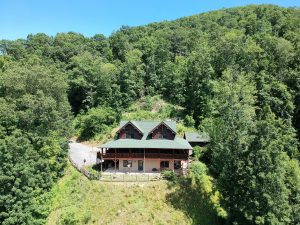Blog
Fall Color Season is Just Around the Corner
Fall color season will shortly be upon us! Labor Day is this coming weekend; October is only 4 weeks away. Our best color viewing here around Maggie Valley depends upon your elevation. The colors begin turning in early October at higher elevations, and move down the mountain from there. Our best colors in the valley are usually around the 20th to the 25th of October. According to the Asheville Citizen Times this year will be an “average season”. This is based on prognosticators’ forecasts. I find they are usually correct about 50% of the time. In other words, flip a coin.
I remember a few years ago Barbara and I travelled to Maine, where she lived as a child. It was color season in Vermont and New Hampshire, so we spent some time there taking in the Fall colors. Oddly enough, the best colors we saw were at the end of our trip, right here in these Smoky Mountains. We are so fortunate to live in a place that has such spectacular vistas, breath-taking waterfalls, and some of the best Fall colors in the USA!
Sooo… come on up to the mountains, the colors should run between good and spectacular. While you’re here, stick your head in the door and say hello.
Maggie Valley will go Dark on Monday August 21st!
We are all waiting for the eclipse on Monday, August 21st. It appears the Moon will start moving in front of the Sun shortly after 1:00 PM. By about 2:30 PM it should be almost totally dark here with some stars visible. By 4:00 PM the Moon will be out of the Sun’s shadow, and hopefully, full daylight will resume. I remember seeing a partial eclipse when I was in elementary school (many years ago), but never a total eclipse. Motels and hotels in Western North Carolina seem to be enjoying a land-office rate of bookings. Our local Ingles grocery store in Waynesville has sold thousands of eclipse viewing glasses.
This brings up an important subject. Do not watch the eclipse without proper eclipse glasses. Doing so can permanently damage your eyes. Also, do not point your camera at the Sun without using a Solar Filter. Solar filters are expensive, and photographing an eclipse is very difficult, even for professional photographers. Trying to take a picture without a proper Solar Filter will destroy your camera.
If you are coming to Western North Carolina for the eclipse, hopefully you have already made reservations for lodging. Also, traffic could be very congested on Monday. If you are planning to go up on the Blue Ridge Parkway to popular spots like Water Rock Knob, Devils Courthouse, Graveyard Fields, or the Black Balsam Parking Area, be sure to leave early, as those spots will fill up rapidly. The National Park Service has announced that Clingmans Dome Road in the Smoky Mountains National Park will be closed on Monday, so don’t even think about going to Clingmans Dome.
The weather forecast for Monday is calling for a 30 percent chance of showers, or thunder showers, in the afternoon. I am keeping my fingers crossed for clear weather, but some clouds are probably a sure bet.
If you are planning on being here Monday, I wish you a happy and memorable time viewing the eclipse.
Mortgage Rates have Dropped Again!
At their last meeting the Federal Reserve voted to leave the key rate alone. Home mortgage rates actually more closely follow the 10 year bond rate than the key rate from the Federal Reserve. (This is because 30 year mortgage loans only last for an average of 10 years as owners sell their homes before the mortgage is paid off.) After the Fed meeting, the 10 year bond yield dropped 2.7 basis points.
As of the week of July 27th, 30 year fixed mortgage rates averaged 3.92 percent, 15 year fixed mortgage rates averaged 3.20 percent, and 5 year hybrid adjustable-rate mortgage averaged 3.18 percent, as reported by Freddie Mac.
Many buyers don’t stop to compute how much difference their payments can be on a small percentage rate difference. Over the life of a 30 year mortgage, the difference in a 3.92 percent rate and a 4.5 percent rate costs the buyer $30,481.20 in additional payments.
Eventually, mortgage rates will rise again. Now is a great time to buy that first home, vacation home, rental property, or retirement home.
If you are thinking about buying your next home, vacation home, or a home for retirement, please give us a call. Likewise, if you are thinking of selling your home, contact us. We will be happy to do a Current Market Analysis and let you know the price of your home in comparison to other homes that have recently sold.
4 Common Home Buyer Slip-Ups
I found this article this morning, and thought the advice to prospective home buyers was “spot on”. We do see buyers shoot themselves in the foot often times. Item number 2 is particularly exasperating. I hope this information benefits some prospective buyers out there.
Real estate professionals see a lot of dumb reasons why home buyers ultimately end up losing out on a deal. Practitioners recently shared some of the more common mistakes with realtor.com®, including ways to correct the situation:
1. Shopping outside their price range.
“It sounds obvious, but some home buyers just have trouble sticking to a budget”, says Benny Kang, a real estate professional in Irvine, Calif. Shopping online may increase the temptation to bump up the price range. One way to avoid this situation is to encourage your buyers to get preapproved for a loan so they know what they can truly afford and stay within their limits.
2. Submitting lowball offers in a hot market.
“If you’re in a seller’s market, making a crazy lowball offer can piss off the seller”, says Kang. Buyers would be smart to offer full price when homes are priced well. Help buyers understand how a comparative market analysis can offer insight into pricing.
3. Making a big purchase while in escrow.
Buyers often don’t realize they will need to delay big purchases and opening new credit lines while in the process of buying a home. “Even buying a fridge can throw off your credit or debt-to-income ratio”, says Kathy Conway, a Philadelphia real estate professional. If a big purchase is made, the mortgage lender’s underwriter will need to re-evaluate the buyer’s finances and recheck her credit report before closing to ensure the buyer still qualifies for the mortgage, so be sure to warn buyers when they’re approaching this period.
4. Forgetting to budget closing costs.
Buyers don’t just need money for the down payment. There are a lot of extra fees at settlement, too. Buyers can receive an estimate from their mortgage lender of what the closing costs will be before even making an offer on a property. Make sure they review that information carefully. Closing costs can vary drastically but typically cost 2 to 7 percent of the home’s purchase price.
Source: “8 Dumb Reasons People Can’t Buy a Home”, realtor.com® (July 11, 2017), and Daily Real Estate News, (Wed July 12, 2017)
First Impressions when Selling your Home
You know the old saying: “One never gets a second chance to make a first impression.” This is a very accurate rule when selling your home. I’m sure you have read all the obvious recommendations, or perhaps have seen them on one of the “fixer upper” TV shows that are so popular now. Have your yard mowed, your shrubs trimmed, no clutter in the yard or in your home, maybe repaint your front door, keep your home spotlessly clean, remove most personal photos, bake cookies just prior to showings. All these suggestions do help make your home more attractive, but remember, when a prospective buyer comes into your home for a showing, this is not their first impression. Their first impression was when they saw your home on the internet from their home computer, or even their cellphone. Or maybe their first impression was sitting in their agent’s office looking at homes on a computer monitor. So, actually, the first impressions of your home by a prospective buyer is the pictures your listing agent took of the home. Is your listing agent a good photographer? Did your listing agent hire a professional photographer? Did your listing agent take drone photos of your home? Take for example the picture shown above. This is a beautiful log home in a gated community. The landscape in front of this home is not flat. It drops off rather quickly. (Like many mountain homes facing the view.) A photographer cannot get far enough away from the front of this home to take a picture. Therefore, the drone photo above. Not only does this photo show the front of the home, but also shows the surroundings, and the privacy this home affords. A good question to ask a prospective real estate agent wanting to list your home is: “Who does your photography?” Even better, find some current listings by this agent and see if you like the photography.
Here at Mountain Dreams Realty, we believe first impressions do matter. That is why we have in-house professional photography, including drone photography. We know you never have a second chance to make that first impression.
How Long Does It Take to Get a Mortgage?
I have been asked by several clients about the mortgage application process and the time involved in getting a mortgage. I found this article from Daily Real Estate News that explains the timing very well, so I thought I would share it. My recommendation would be to get pre-approved for a mortgage before even looking for a home to purchase. As the market turns more and more to a seller’s market, having a pre-approval letter with your offer definitely lends your offer more weight.
“Today’s mortgage process is very involved, particularly with regard to the documentation required, third-party verifications, and the independent appraisal process” says Whitney Fite, president of Angel Oak Home Loans in Atlanta. “All of these moving parts can cause a delay in processing if an issue arises.”
The entire process encompasses getting preapproved, a home appraisal, and getting the actual loan. Typically, the process takes about 30 days, on average, Fite says.
However, in busier times of year, consumers should expect a longer wait. For example, a duration of 45 to 60 days, depending on the lender, may be more of the norm, according to a recent article at realtor.com®.
Consumers may be best off making sure they get an early start to the mortgage process from the moment they even start thinking they may want to purchase a property. Many sellers require buyers now get preapproved for a mortgage before they’ll even accept an offer.
For a preapproval, lenders will check the consumer’s credit rating, debt-to-income ratio, and other financial information. That alone may take a week or even longer, depending on the borrower’s circumstances.
But buyers shouldn’t confuse a preapproval for having an actual mortgage loan. Borrowers still have to apply for the actual loan and also get through the appraisal process. Also, in the underwriting process, lenders will review all of their financial information and ensure the home buyer has not made any false or misleading claims on their application.
Fite says the most common reason for a mortgage-related delay is the borrower not turning in documents in a timely manner.
“The best advice I can give someone buying a home is to prepare to respond very quickly for any and all documentation requests,” Fite says.
Source: “How Long Does it Take to Get a Mortgage? Longer Than You Might Think,†realtor.com® (June 12, 2017)
Illuminate Listings Without Breaking the Bank
This is an article from Realtor Magazine that I wanted to Share:

The proper illumination can shine a crisp spotlight, spread a wide beam, or cast a warm glow on a home’s best features to make a listing more appealing to buyers. Thankfully, most sellers don’t need to hire an electrician, install recessed cans, or purchase expensive fixtures in order to gain the benefits of this type of staging.
Updated lighting not only helps your listing stand out visually but also attracts buyers eager to save energy and electricity costs. Here are a few ways you and your clients can take advantage of the latest developments in the lighting industry.
 Add layers to enhance room function and mood. When evaluating an area’s lighting needs, make sure there are three layers of light. Ambient light creates a backdrop and should provide overall brightness without glare. Ensure there’s adequate task lighting to help homeowners perform typical functions for whatever space they’re in (under-cabinet lights to safely prep food in a kitchen, night lights for reading comfortably in bed, or a desk lamp for paperwork in an office). Accent lighting can draw attention to some appealing features, such as a striking kitchen island, large painting, or even a lovely mature tree in the backyard.
Add layers to enhance room function and mood. When evaluating an area’s lighting needs, make sure there are three layers of light. Ambient light creates a backdrop and should provide overall brightness without glare. Ensure there’s adequate task lighting to help homeowners perform typical functions for whatever space they’re in (under-cabinet lights to safely prep food in a kitchen, night lights for reading comfortably in bed, or a desk lamp for paperwork in an office). Accent lighting can draw attention to some appealing features, such as a striking kitchen island, large painting, or even a lovely mature tree in the backyard.
 Increase energy efficiency. Many buyers are looking for energy savings in a home, and LED bulbs will greatly reduce heat output and conserve energy. Pam Price, head of retail marketing at LEDVANCE, which manufactures the Sylvania bulb brand, pegs the energy reduction for LEDs at 85 percent less than incandescent bulbs. Some sellers may be reluctant because they think LED light is too cool or the bulbs are expensive and nonfunctional with dimmers—all of which was once true, but has changed since the first generation debuted. In addition to the initial cost saving, LED bulbs typically last 25 times longer than incandescent bulbs, which are being phased out due to more stringent government energy requirements. Consumers can find each bulb’s life expectancy, generally in hours, on the package. Sellers should also find out if their local utility company offers rebates if they purchase such LED bulbs, says Joseph A. Rey-Barreau, an architect and a lighting consultant for the American Lighting Association.
Increase energy efficiency. Many buyers are looking for energy savings in a home, and LED bulbs will greatly reduce heat output and conserve energy. Pam Price, head of retail marketing at LEDVANCE, which manufactures the Sylvania bulb brand, pegs the energy reduction for LEDs at 85 percent less than incandescent bulbs. Some sellers may be reluctant because they think LED light is too cool or the bulbs are expensive and nonfunctional with dimmers—all of which was once true, but has changed since the first generation debuted. In addition to the initial cost saving, LED bulbs typically last 25 times longer than incandescent bulbs, which are being phased out due to more stringent government energy requirements. Consumers can find each bulb’s life expectancy, generally in hours, on the package. Sellers should also find out if their local utility company offers rebates if they purchase such LED bulbs, says Joseph A. Rey-Barreau, an architect and a lighting consultant for the American Lighting Association.
Two simple steps will help sellers improve lighting in their homes without any technological wizardry and minimal expense:
Make rooms airy and bright. This option is not only easy, it’s also completely free. Advise sellers to remove heavy draperies and other window treatments to let in as much natural light as possible, says Nancy Goldstein, principal of Light Positive, a lighting design firm in Marblehead, Mass. The more natural light, the fewer bulbs have to be added.
Check that bulbs work. It sounds basic, and it is, but homeowners may not notice bulbs that have died, especially in fixtures with multiple bulbs or in closets and less frequently used spaces such as attics and some basements.
Explore DIY options. Not only have these new lighting options come down in price over the years, LED options are also often much easier to install, even in some cases by DIYers. Under kitchen cabinets, sellers can easily attach modular strips with adhesive for much-needed task lighting. Rey-Barreau says a 24-inch strip will cost between $30 and $50 and is much easier for a DIYer than the old sockets that had to drilled into the base of cabinets.
Enhance safety. Smart lighting choices can also help alleviate buyers’ concerns about safety. Programmable systems can turn lights on and off in a room or entire house to avoid a vacant home look. Once pricey and complicated to install because they had to be hardwired, new options are wireless and less time-consuming and costly to install. They’re also more user-friendly to operate and can be controlled from smart devices and security systems, says Nancy Goldstein, a principal with Light Positive, a lighting design resource in Marblehead, Mass.
Play up the outdoors. Landscape lighting can also enhance safety while helping to highlight textures and plants outdoors, says Rey-Barreau. It brings the outdoors in to expand a home’s sense of space. “It minimizes the confining ‘black mirror’ effect that large areas of glass can produce when there’s no view beyond the panes at night,†says Goldstein. Costs here have also come down thanks to starter kits with four to eight lights available for $100 to $200, says Joe Dugandzic, executive producer and editorial director of Smarter Home Life, a website and YouTube channel about home automation and lighting.
Choose the right bulb and fixture. Too many sellers still buy bulbs on sale or don’t pair the right bulb with the right fixture for the desired need, says Dugandzic. For example, he suggests using an uplight-style lamp to illuminate a dark corner. Homeowners should consider light output or brightness (measured in lumens, rather than watts) and the color temperature, from warm white to cool blue (measured in Kelvins). Thanks to Federal Trade Commission requirements, manufacturers must now label packages with a “Lighting Facts†box that details this information as well as the bulb’s life expectancy, energy use, and estimated annual costs.
Experts differ on specifics but here are a few tips from John Hales, owner of Mr. Electric of Greater Augusta, a Georgia company specializing in electrical installation and repair services, about what should be used where:
- Living room. Mixed lighting should reflect the many ways this room can be used. Try adjustable lamps paired with three-way LED bulbs from 1,500 to 3,000 lumens and 2,200–3,000K in the color temperature range.
- Dining room. Dimmable fixtures paired with dimmable LEDs allow for brightness to be varied from 3,000 to 6,000 lumens and 2,200–3,000K. Make sure clients know different LED bulbs require different dimmers and are not interchangeable.
- Kitchen. Because of the different functions of this versatile room, good ranges are from 4,000 to 8,000 lumens and 2,700–5,000K.
- Bedroom. To preserve circadian rhythms, go for 1,500 to 4,000 lumens and a color temperature range of 2,700–3,000K.
- Bathroom. Task lighting around a mirror and general overhead lighting should be bright, from 4,000 to 8,000 lumens and in the 3,000–5,000K range.
- Home office. Cool white lights in the 3,000 to 6,000 lumens and 3,500–5,000K color range can spur productivity.
 Introduce sizzle. Lighting has a sexy side that can help differentiate listings in an affordable way. The newest bulbs render color more accurately than in years past. Some bulbs can change color to cast different moods. LED bulbs are also showing up in new, unexpected places such as illuminated showerheads, says Rey-Barreau. And some manufacturers are adding a hip factor by offering connectivity using Bluetooth, allowing homeowners to control lighting from the same devices that they use to control temperature, locks, garage doors, and other accessories.
Introduce sizzle. Lighting has a sexy side that can help differentiate listings in an affordable way. The newest bulbs render color more accurately than in years past. Some bulbs can change color to cast different moods. LED bulbs are also showing up in new, unexpected places such as illuminated showerheads, says Rey-Barreau. And some manufacturers are adding a hip factor by offering connectivity using Bluetooth, allowing homeowners to control lighting from the same devices that they use to control temperature, locks, garage doors, and other accessories.
Before Putting Your Home Up For Sale
The below article is from Realtor Magazine, but I thought it merited sharing with all of you.
Here are a few items to take care of before listing your home. This can make the sale process quicker and easier in the long run.
Consider a pre-sale home inspection. An inspector will be able to give you a good indication of the trouble areas that will stand out to potential buyers, and you’ll be able to make repairs before open houses begin.
Organize and clean. Pare down clutter and pack up your least-used items, such as large blenders and other kitchen tools, out-of-season clothes, toys, and seasonal items. Store items off-site or in boxes neatly arranged in the garage or basement. Clean the windows, carpets, walls, lighting fixtures, and baseboards to make the house shine.
Get replacement estimates. Do you have big-ticket items that will need to be replaced soon? Find out how much it will cost to repair an older roof or replace worn carpeting, even if you don’t plan to do so. The figures will help buyers determine if they can afford the home, and they’ll be handy when negotiations begin.
Locate warranties. Gather up the warranties, guarantees, and user manuals for the furnace, washer/dryer, dishwasher, and any other items that will remain with the house. It may seem like this task can be left until closing, but you don’t want lost paperwork or last-minute scrambling to cause the deal to fall through.
Spruce up the curb appeal. Walk out to the front of your home, close your eyes, and pretend you’re a prospective buyer seeing the property for the first time. As you approach the front door, what is your impression of the property? Do the lawn and bushes look neatly manicured? Is the address clearly visible? What do you see framing the entrance, if anything? Is the walkway free of cracks and impediments?
Shop for the Best Mortgage Rate
Home buyers who  don’t gather more than one quote when shopping for a mortgage may be losing out on some savings to their monthly payments.
don’t gather more than one quote when shopping for a mortgage may be losing out on some savings to their monthly payments.
Lenders can offer a wide dispersion of rates, up to 50 basis points or 0.5 percent, after controlling for factors like the borrower’s down payment and credit score. That could be the difference between a 3.5 percent versus a 4 percent mortgage rate, according to a recent study by two economists at the Consumer Financial Protection Bureau, who culled mortgage data from 2014.
The authors offer up a scenario of what would happen if consumers had done an additional search for rate offers. Just one extra search could potentially reduce a borrower’s monthly payment by $8.63, on average. Adding five more searches could help them reduce their payments by $17.03 per month (that’s about $204 over just one year in savings). That said, the borrower’s initial offer may end up being the strongest in some cases, despite additional searches, the authors also note.
But in general, the researchers say that borrowers’ shopping around forces lenders to compete and likely will reduce the costs the borrower will end up paying.
“Tell your clients, especially first-time buyers, to shop more,” notes the National Association of REALTORS® Economists’ Outlook blog, interpreting the study’s results. “It may save them money. They should use websites that quote multiple lenders and get multiple offers on their own from large retail lenders, smaller banks or credit unions, and mortgage banks. But always consider the total cost, which includes the lenders’ fees and other services.”
Source: “Sometimes, Shopping Will Save Your Clients Money!” National Association of REALTORS® Economists’ Outlook blog (April 25, 2017)
Elk in Maggie Valley and Other Ramblings
Paul took this shot of Elk crossing Soco Road in Maggie Valley. It seems since elk were reintroduced into the Cataloochee area of the Great Smoky Mountains National Park, elk sightings in the valley have become common place. When you visit the valley, please keep an eye out for these critters. Besides not wanting to hurt a poor elk, they can weight almost 1000 pounds and do considerable damage to a vehicle.
The Cataloochee area of the park is still the best place to consistently view the elk. The best times of day is the early morning, and late evening before sunset. To get to the Cataloochee Valley, take Highway 276 North (the Jonathan Creek Road) almost to the end. When you see the I40 bridge up ahead, make a left onto Cove Creek Road. The pavement will end and Cove Creek Road will turn to a curving gravel mountain road. Stay on the gravel road for about 3 miles and you will come to a paved road. Make a left and follow this paved road down the mountain into the valley. Continue on until you see open fields. The open fields are the best place to see the elk. If you continue past the end of the pavement, there are more open fields, an old church, school, home and barn in the upper fields. There are also several hiking trails and great places for a picnic.
Home sales in the county remain strong, although inventories are getting thin. When a nice home in the 100 to 300 thousand price range comes on the market, it can be under contract very quickly. Lyndia Massey in our office listed a home in Clyde last Sunday. It was under contract the next day. Paul listed two homes in the Jonathan Creek area and both were under contract within 10 days. If you are a buyer and find a home you like, make an offer quickly.
Come on up to the mountains, we’ll be waiting for you.





